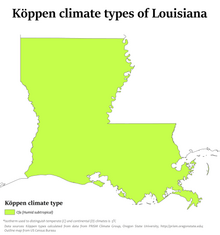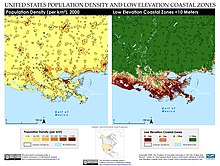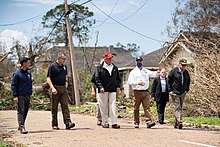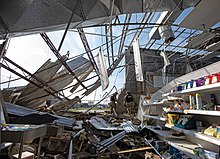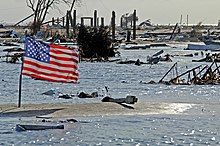
The Gulf Coast of the United States, also known as the Gulf South or the South Coast, is the coastline along the Southern United States where they meet the Gulf of Mexico. The coastal states that have a shoreline on the Gulf of Mexico are Texas, Louisiana, Mississippi, Alabama, and Florida, and these are known as the Gulf States.

Hurricane preparedness in New Orleans has been an issue since the city's early settlement because of its location.
Drainage in New Orleans, Louisiana, has been a major concern since the founding of the city in the early 18th century, remaining an important factor in the history of New Orleans today. The central portion of metropolitan New Orleans is fairly unusual in that it is almost completely surrounded by water: Lake Pontchartrain to the north, Lake Borgne to the east, wetlands to the east and west, and the Mississippi River to the south. Half of the land area between these bodies of water is at or below sea level, and no longer has a natural outlet for flowing surface water. As such, virtually all rainfall occurring within this area must be removed through either evapotranspiration or pumping. Thus, flood threats to metropolitan New Orleans include the Mississippi River, Lake Pontchartrain, canals throughout the city, and natural rainfall. Artificial levees have been built to keep out rising river and lake waters but have had the negative effect of keeping rainfall in, and have failed on numerous occasions.

The effects of Hurricane Isaac in Louisiana were more severe than anywhere in the storm's path, and included $611.8615 million in damages and five total deaths. Forming from a tropical wave in the central Atlantic, Isaac traversed across many of the Lesser and Greater Antilles, before reaching peak intensity with winds of 80 mph (130 km/h) on August 28, 2012 while in the Gulf of Mexico. Nearing the coast of Louisiana, the Category 1 hurricane slowly moved towards the west, making two landfalls in the state with little change of intensity prior to moving inland for a final time. The hurricane weakened and later dissipated on September 1 while over Missouri. Before landfall, Governor Bobby Jindal declared a state of emergency to the state, as well as ordering the mandatory evacuation of 60,000 residents in low-lying areas of Louisiana along the Tangipahoa River in Tangipahoa Parish.

Coastal erosion in Louisiana is the process of steady depletion of wetlands along the state's coastline in marshes, swamps, and barrier islands, particularly affecting the alluvial basin surrounding the mouth of the Mississippi River. In the last century, Southeast Louisiana has lost a large portion of its wetlands and is expected to lose more in the coming years, with some estimates claiming wetland losses equivalent to up to one football field per hour. One consequence of coastal erosion is an increased vulnerability to hurricane storm surges, which affects the New Orleans metropolitan area and other communities in the region. The state has outlined a comprehensive master plan for coastal restoration and has begun to implement various restoration projects such as fresh water diversions, but certain zones will have to be prioritized and targeted for restoration efforts, as it is unlikely that all depleted wetlands can be rehabilitated.

Climate change in Alabama encompasses the effects of climate change, attributed to man-made increases in atmospheric carbon dioxide, in the U.S. state of Alabama.

In contrast to other parts of the United States, Arkansas has not seen a significant increase in temperature over the last 50–100 years. In fact, some parts of the state have cooled. However, the state does receive more annual rainfall and more frequent downpours than other states. Over the next few decades, Arkansas is expected to warm, experiencing an increased severity of flooding and droughts. It is also expected to suffer more storm damage, reduced agricultural yields, and harm to livestock. Arkansas might also have to contend with a heightened risk of heat-related illnesses. In addition, there has been an increase in the number of tornadoes observed in the central United States, including Arkansas.

Climate change in Connecticut encompasses the effects of climate change, attributed to man-made increases in atmospheric carbon dioxide, in the U.S. state of Connecticut.

Climate change in Delaware encompasses the effects of climate change, attributed to man-made increases in atmospheric carbon dioxide, in the U.S. state of Delaware.

Climate change in Georgia encompasses the effects of climate change, attributed to man-made increases in atmospheric carbon dioxide, in the U.S. state of Georgia.
Climate change in Guam encompasses the effects of climate change, attributed to man-made increases in atmospheric carbon dioxide, in the U.S. territory of Guam.

Climate change in Minnesota encompasses the effects of climate change, attributed to human-caused increases in atmospheric carbon dioxide, in the U.S. state of Minnesota.

Climate change in Mississippi encompasses the effects of climate change, attributed to man-made increases in atmospheric carbon dioxide, in the U.S. state of Mississippi.

Climate change in the United States Virgin Islands encompasses the effects of climate change, attributed to man-made increases in atmospheric carbon dioxide, in the U.S. territory of the United States Virgin Islands. The United States Environmental Protection Agency (EPA) has noted a variety of expected consequences of this phenomenon.
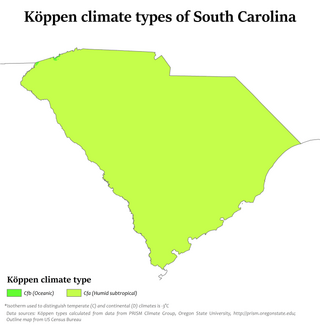
Climate change in South Carolina encompasses the effects of climate change, attributed to man-made increases in atmospheric carbon dioxide, in the U.S. state of South Carolina.

Climate change in Tennessee encompasses the effects of climate change, attributed to man-made increases in atmospheric carbon dioxide, in the U.S. state of Tennessee.
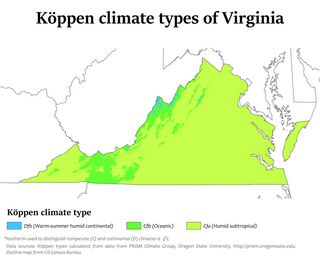
Climate change in Virginia encompasses the effects of climate change, attributed to man-made increases in atmospheric carbon dioxide, in the U.S. state of Virginia.

Climate change in New Jersey is of concern due to its effects on the ecosystem, economy, infrastructure, and people of the U.S. state of New Jersey. According to climatology research by the U.S. National Oceanic and Atmospheric Administration, New Jersey has been the fastest-warming state by average air temperature over a 100-year period beginning in the early 20th century, related to global warming.

The climate in Texas is changing partially due to global warming and rising trends in greenhouse gas emissions. As of 2016, most area of Texas had already warmed by 1.5 °F (0.83 °C) since the previous century because of greenhouse gas emissions by the United States and other countries. Texas is expected to experience a wide range of environmental impacts from climate change in the United States, including rising sea levels, more frequent extreme weather events, and increasing pressure on water resources.

Climate change in Pennsylvania encompasses the effects of climate change, attributed to man-made increases in atmospheric carbon dioxide, in the U.S. state of Pennsylvania.
